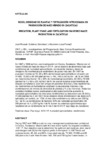
Please use this identifier to cite or link to this item:
http://ricaxcan.uaz.edu.mx/jspui/handle/20.500.11845/936Full metadata record
| DC Field | Value | Language |
|---|---|---|
| dc.contributor.other | 0000-0001-7861-4780 | es_ES |
| dc.contributor.other | https://orcid.org/0000-0001-7861-4780 | - |
| dc.coverage.spatial | Zacatecas, México | es_ES |
| dc.creator | Gutiérrez Sánchez, José Ricardo | - |
| dc.creator | Luna Flores, Maximino | - |
| dc.date.accessioned | 2019-04-08T18:26:14Z | - |
| dc.date.available | 2019-04-08T18:26:14Z | - |
| dc.date.issued | 2002 | - |
| dc.identifier | info:eu-repo/semantics/publishedVersion | es_ES |
| dc.identifier.issn | 0568-2517 | es_ES |
| dc.identifier.uri | http://ricaxcan.uaz.edu.mx/jspui/handle/20.500.11845/936 | - |
| dc.identifier.uri | https://doi.org/10.48779/m527-hb56 | - |
| dc.description | In the semiarid highlands of Mexico, rainfall has an erratic distribution and therefore, maize and bean yields are low. In this region the rainfall season may be classified as “normal” or “delayed”, according to the onset of the rainy season. Whenever sowing time has to be delayed due to the late onset of rains, the risk of drought and crop damage by low temperatures increases. The objective of this research was to evaluate and promote possible alternative crops under normal and late rainfall, with and without supplemental irrigation to reduce production risks in rainfed areas. The experiment was established in two locations, Sandovales and Montoya in the county of El Llano, Aguascalientes, during 1999 and 2000. Three factors were evaluated: a) alternative crops: barley, oat, triticale, wheat, and chickpea with dry beans and maize as controls; b) sowing dates: normal and delayed; and c) soil moisture regimes: rainfall with and without supplemental irrigation. In both years the onset of rains was normal. Dry matter and grain yield were recorded. Results indicated that soil moisture conditions were more favorable in the first sowing date in both years and sites, which was reflected in higher dry matter and grain yield; a similar response was observed with supplemental irrigation in both planting dates. The alternative crops showed tolerance to low temperatures. Maize for forage production is a good option under normal planting with or without supplemental irrigation, and although it is still a good option under delayed planting, oat or triticale can also be good alternatives. Crops having a long growth cycle such as maize and chickpeas have a higher risk for grain production under delayed planting dates. Dry beans and oat for grain production showed good response under normal planting with or without supplemental irrigation. | es_ES |
| dc.description.abstract | En la región del Altiplano Semiárido de México las lluvias tienen distribución errática y el rendimiento del maíz y frijol es bajo. El temporal, según el inicio de las lluvias en la región, se puede clasificar en normal y tardío. Las siembras que se realizan en fechas tardías incrementan el riesgo por sequía y por bajas temperaturas durante el desarrollo de los cultivos. El objetivo de la investigación fue evaluar diversos cultivos en temporal normal y tardío, con y sin riego de auxilio, para reducir los riesgos de producción en las áreas de temporal del Altiplano Semiárido de México. Los experimentos se establecieron en Sandovales y Montoya en el municipio de El Llano, Aguascalientes, México, en los ciclos 1999 y 2000. Se evaluaron tres factores: a) cultivos alternativos: cebada, avena, triticale, trigo, garbanzo y los testigos frijol y maíz; b) fechas de siembra: temporal normal y temporal tardío y c) niveles de humedad: temporal solo y temporal más un riego de auxilio. En todos los cultivos se determinó la producción de materia seca y grano. Las condiciones de humedad fueron más favorables en la época de siembra normal en ambos años y sitios, lo que se reflejó en mayor rendimiento de materia seca y grano; una respuesta similar ocurrió con el riego de auxilio en ambas fechas de siembra. Los cultivos alternativos al frijol y maíz mostraron tolerancia a las heladas. El maíz para forraje es una opción para temporal normal con y sin riego de auxilio y también para temporal tardío, aunque puede sustituirse por avena o triticale. Los cultivos de ciclo largo como el maíz y el garbanzo mostraron alto riesgo para producir grano en siembras tardías; el frijol y la avena mostraron buena respuesta en siembras normales con y sin riego suplementario. | es_ES |
| dc.language.iso | spa | es_ES |
| dc.publisher | Instituto Nacional de Investigaciones Forestales, Agrícolas y Pecuarias | es_ES |
| dc.relation.uri | generalPublic | es_ES |
| dc.rights | Atribución-NoComercial-CompartirIgual 3.0 Estados Unidos de América | * |
| dc.rights.uri | http://creativecommons.org/licenses/by-nc-sa/3.0/us/ | * |
| dc.source | Agricultura Técnica en México, Vol. 28, 2002, pp. 95-103 | es_ES |
| dc.subject.classification | CIENCIAS AGROPECUARIAS Y BIOTECNOLOGIA [6] | es_ES |
| dc.subject.other | Temporal normal y tardío | es_ES |
| dc.subject.other | riego suplementario | es_ES |
| dc.subject.other | fechas de siembra | es_ES |
| dc.subject.other | producción de grano y materia seca | es_ES |
| dc.subject.other | maíz | es_ES |
| dc.subject.other | frijol | es_ES |
| dc.title | Riego, densidad de plantas y fertilización nitrogenada en producción de maíz híbrido en Zacatecas | es_ES |
| dc.type | info:eu-repo/semantics/article | es_ES |
| Appears in Collections: | *Documentos Académicos*-- UA de Agronomía | |
Files in This Item:
| File | Description | Size | Format | |
|---|---|---|---|---|
| Riego, densidad de plantas.pdf | 51,02 kB | Adobe PDF |  View/Open |
This item is licensed under a Creative Commons License
